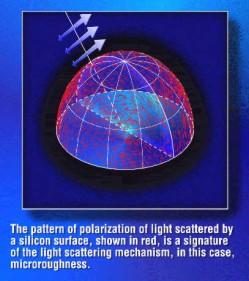Summary
We study how material properties, surface topography, and contaminants affect the distribution of light scattered from surfaces. Our aim is to support industry by developing standard measurement methods and standard artifacts, and providing a basis for interpreting scattered light distributions. Optical scattering can be used in the evaluation of highly polished optical surfaces, bulk optical materials, surface residues, and diffuse scattering materials. It can also aid in assessing the uniformity of periodic structures such as found on compact disks, patterned photoresists, and deposited lines on semiconductors. Experiments are underway to correlate the optical scatter from silicon wafers with surface microroughness, particulate contamination, and subsurface defects to facilitate optical scattering measurements in assembly line applications.
Description

Light Scattering Ellipsometry:
The polarization of scattered light can often indicate the source of that scattered light. Using Light Scattering Ellipsometry, whereby the polarization of light scattered into directions out of the plane of incidence is measured for a fixed incident polarization, scattering from microroughness, subsurface defects, and particulate contamination can be distinguished. Experimental measurements and theoretical modeling have been carried out to demonstrate this effect in a variety of systems:
• Roughness of a single material (silicon, glass, steel, and titanium nitride)
• Subsurface defects (fused silica, glass ceramic, and subsurface defects in silicon)
• Roughness of a dielectric layer (SiO2 and polymer films on silicon)
• Particles above a single interface (polystyrene, copper, and gold spheres on silicon)
• Particles above a thin film (polystyrene spheres on polystyrene films on silicon)
• Special-effect pigmented coatings (metallic and pearlescent flakes)
• Overlay structures
Placing the technique on a firm metrological basis, so that it is quantitatively accurate, is a high priority of the program. Polarized light scattering in the Stokes-Mueller representation is also studied.
Model Software:
SCATMECH: Polarized Light Scattering C++ Class Library − A C++ object class library has been developed to distribute models for polarized light scattering from surfaces. It is the intent of this library to allow researchers in the light-scattering community to fully utilize the models described in our publications. Included in the library are also a number of classes that may be useful to anyone working with polarized light. The library is constructed so that it can easily be expanded to include new models.
Modeled Integrated Scatter Tool (MIST) − The MIST program has been developed to provide users with a general application to model an integrated scattering system. The program performs an integration of the bidirectional reflectance distribution function (BRDF) over solid angles specified by the user and allows the dependence of these integrals on model parameters to be investigated. The models are provided by the SCATMECH library of scattering codes.
Resources:
A laser-based goniometric optical scatter instrument (GOSI) is available for measuring the bidirectional reflectance distribution function (BRDF), its polarization counterpart (Mueller matrix BRDF), or other light scattering ellipsometry parameters, from a variety of samples or surfaces. This instrument is housed in a clean environment to maintain sample integrity. For more details, see Bidirectional optical scattering facility. Other instruments exist within the division under Spectrophotometry.

